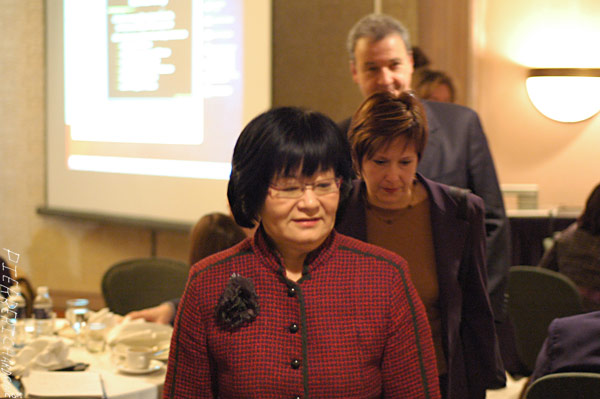Further to the March 2006 National Policy and Chalmers Conferences, the Board of Governors of the Canadian Conference of the Arts (CCA) has established the following set of short, mid and long-term Policy and Advocacy Priorities as guidelines to the actions of the CCA Secretariat. As explained hereafter, while short term priorities require the immediate attention and resources of the CCA and may well in fact develop into mid to long term ones, it is obvious that mid and long-term priorities require some form of action and attention immediately if they are ever to be attained. It is also understood that CCA's priorities will have to be adjusted from time to time depending on policy developments in the various files which are beyond its control.
Short Term Policy and Advocacy Priorities (6-8 months)
These priorities are to be engaged immediately and command the most energy, within the realities of a political agenda the CCA does not control. They will be pursued until achieved or formally abandoned by the CCA, in consultation with its members.
- Increased and stable funding: Increased and stable federal funding for the arts and cultural sector is the highest priority for the CCA. This includes an adequate and stable increase to the budget of the Canada Council for the Arts, funding for international activity by artists and arts organizations and support for the various Canadian Heritage Portfolio agencies and programs; notably, but not limited to, the CBC and Telefilm.
The CCA also supports the efforts of the Canadian Museums Association (CMA) for the implementation and increased funding of a new national museums policy. The CCA will support the CMA in its role as the primary advocate for this objective.
- Equity, artists and the arts: Equity, fair treatment for artists is the meaning of "Status", a long standing priority for CCA. On the top of the list is CCA's focus on taxation issues, which include: the exemption of copyright income, income averaging, and tax exemption of grants. Other equity issues that require priority attention in the medium and long-term include bankruptcy protection, benefits, health and safety, independent contractor status, fair procurement policies and collective rights. CCA's commitment is to support and encourage provincial status legislation and programs, and to this end a mid-term priority is to develop research and action tools to promote further provincial development. Recently added to the advocacy list is the issue of expanding the tax credit for the participation of under-16 year old children in all forms of artistic training, to parallel the tax credit for sports.
- Canadian content and Canadian ownership regulation: Maintaining the integrity of Canadian regulatory policies in the cultural industries is an issue that will come to the fore in this time period. Negotiations at the World Trade Organization (WTO) dealing with the General Agreement on Trade in Services (GATS) are expected to seriously challenge Canadian ownership and content restrictions and support in the audio-visual sector.
Coupled with domestic reviews of our telecommunications and broadcast industries, as well as the possible review of the mandates of the national public broadcaster and of the Commission on Canadian Radio-television and Telecommunications Commission (CRTC), the integrity of our current regulatory policies will be under the microscope. Similar regulatory regimes, such as in book publishing and sound recording may be vulnerable as well.
- Cultural diversity: This has two important facets: the promotion of cultural diversity globally and the assessment of the impact of international trade agreements on global and national diversity; and the recognition and engagement of culturally diverse communities across Canada in the life of arts and culture sector and within the CCA.
The first aspect of cultural diversity, namely the ratification of the 2005 UNESCO Convention on Cultural Diversity and the impact of trade treaties, is an immediate concern for the CCA. The CCA will urge the Canadian government to keep the leadership role it has played over the past decade in putting the issue of cultural diversity on the international agenda. The CCA will, amongst other things, support the work of the Coalition on Cultural Diversity and of the International Network on Cultural Diversity, as well as engage the UNESCO process where appropriate.
The CCA will also constantly inform its members and stakeholders on the impact of international agreements on Canadian culture and on global cultural diversity.
Domestically, the CCA will pursue initiatives aimed at including Canada's diverse communities to participate as catalysts in debates regarding cultural policies and programs (see Long Term Priorities below).
- Election Readiness: the 39th Parliament of Canada is once again on the minority government high wire. The CCA must prepare for the possibility of a federal election at any time in the coming months. The issues of importance to the arts and cultural sector must draw the attention of the political parties engaged in a federal election in a comprehensive and constructive manner. A strategy and instruments must be developed in the coming months to help our membership contribute to putting arts and culture on the political agenda.
Medium Term Policy and Advocacy Priorities (8-18 months)
These priorities are also to be engaged immediately, but with a longer view perspective and once again, subject to the realities of a political agenda the CCA does not control. They will be pursued until achieved or formally abandoned by the CCA, in consultation with its members.
- Arts, culture and International policy: Canada's international policy will likely be addressed during the life of the 39th Parliament. Proposed changes brought forward by the previous government scrapped the "Third Pillar" of Canadian foreign policy (the promotion of Canadian culture and values) with a diluted approach to public diplomacy. The CCA will engage the Department of Foreign Affairs and the Standing Committee on Foreign Affairs in discussions to ensure that the Third Pillar undertaking returns to a Canadian foreign policy position.
- Forecast legislative changes: Parliamentary and legislative business as well as will also arise during this medium term. Revisions to the Copyright Act, further changes to the Criminal Code addressing the criminalization of creative expression, the new Federal Accountability Act and other developments will remain priorities for the CCA where the interests of the arts and cultural sector are potentially affected.
- Recasting the arts and culture advocacy arguments and strategy: Reframing the arts and culture sector is a high priority but one that will require the investment of time, energy and intellectual rigor. The recent CCA National Policy Conference sent the message of the importance of doing so loudly and clearly.
Elements of this thrust include the development of the concept of "Cultural Citizenship", reframing outstanding elements from the status of the artist discussion, and underscoring the role of the arts and culture sector in the panorama of Canadian civic life.
The CCA is determined to widen its network of contacts within civil society to both strengthen the understanding of the arts and culture sector but also to provide support to those organizations that work for the benefit of Canadian society. While the CCA is already engaged in several such networks, a thoughtful and strategic approach to widening such involvement will be a long-term continuous priority.
- Developing a coherent cultural policy framework: the CCA also heard the call from its membership for the development of a comprehensive and coherent cultural policy framework. This would replace the abandoned notion of developing an overarching federal cultural policy. Logically, such an initiative can flow from the work of medium term priority 3 and will involve exploring the idea of a Canadian Charter of Cultural Principles, which could be the touchstone of any policy or regulatory decision affecting Canadian artists and cultural organizations and agencies.
Long Term Policy and Advocacy Priorities (18 months and beyond)
Work on these priorities is to be engaged immediately, but with an even longer view perspective.
- Youth engagement: Succession planning for the arts and culture sector is a high priority given the imminent retirement of the baby-boomers and many of the founders of arts and cultural organizations and enterprises. The CCA will work with the Cultural Human Resource Council (CHRC) to address this issue. Internally, the CCA will develop ways of creating a youth steering committee to bring recommendations forward to the Board as how best to involve young Canadians as leaders directly in the work of the arts and culture sector. Last, the CCA will continue its efforts in the area of arts and education and learning, through a committee of the Board and through strategic discussions with national partners and stakeholders.
- Promote cultural diversity at home: The CCA will develop a strategy to extend its membership amongst aboriginal and culturally diverse groups across the country to better reflect and foster Canadian cultural diversity. It will also seek partners to promote the engagement of those communities of Canada as active contributors to the organizational and public policy discourse. Given the changing demographics in Canadian society, the engagement of youth diverse communities is a priority for the long-term health and representative mission of the CCA as a democratic and just organization.
- Develop a national training program on government relations: As part of the Human Resources Development Program to be developed, the CCA will develop a training program of professional development seminars for ASOs, with on-staff expert advisors and skills development seminars on site across Canada on Government and Parliamentary relations and federal cultural policy.
- Promote the adoption of the developed cultural policy framework:The CCA will develop a plan to leverage its status as a "network of networks" to promote the adoption by Parliamentarians of a Canadian Charter of Cultural Principles against which policies and regulatory decisions affecting artists and the cultural sector at large can be assessed and amended if necessary.
Read more!


